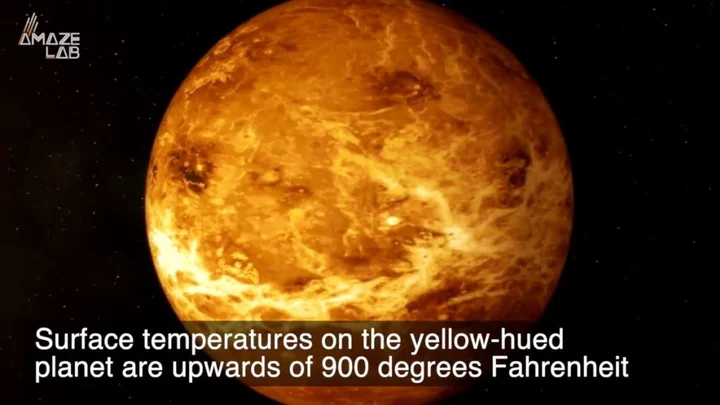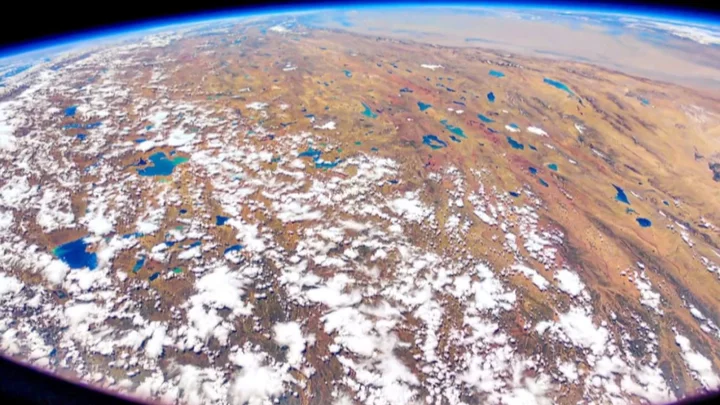
Mexcian girl who was bullied at school has a higher IQ than Einstein and Stephen Hawking
A young girl who was bullied for being autistic may have a higher IQ than Stephen Hawking or Albert Einstein. Adhara Maite Pérez Sánchez, an 11-year-old from Tláhuac, Mexico, is being described as a prodigy by many after recently graduating with a degree in Systems Engineering. She is now going on to study industrial engineering. The extraordinary girl has a passion for astronomy and space, expressing the dream to become the first Mexican woman to travel to space as an astronaut and has given talks about her interest and knowledge of aerospace. She intends to become an astronaut at NASA, and is currently taking courses in astronomy and gravitational waves at the National Autonomous University of Mexico (UNAM), which is widely regarded as a top research university. Sign up to our free Indy100 weekly newsletter Adhara has also had her achievements recognised in 2021 by the Senate of the Republic, as well as being declared one of Mexico’s 100 most influential women, and appearing on the cover Marie Claire Mexico. However, life hasn’t always been easy for Adhara, who struggled with being bullied by her classmates. Often labelled as a ‘weirdo’ for her autism. Adhara was diagnosed with Asperger’s at 3 years old, but has succeeded greatly with it. Recently she has begun developing a bracelet designed to monitor the emotions of children such as herself in order to improve their communication skills. But she hasn’t let the negativity bring her down. Determined to succeed and achieve her goals in spite of what others say about her. Her inspirations include late physicist, Stephen Hawking, and Carmen Félix, a Mexican engineer currently developing a plan to launch a manned mission to Mars. Have your say in our news democracy. Click the upvote icon at the top of the page to help raise this article through the indy100 rankings.
2023-05-23 00:29

Brains of three suspected zombies scanned in Haiti
Researchers in Haiti once scanned the brains of three people believed to be long-deceased individuals returning from the dead - or zombies. In a study published in 1997, researchers investigated three such cases, using electroencephalography and DNA testing techniques to try and find a rational explanation for a Haitian Voodoo theory that the spirits of the dead can be captured by sorcerers called bokors, who use these souls to reanimate fresh corpses into zombies who walk around rural areas. One case involved a woman who had died aged 30 and was spotted three years later by family members who recognised her because of a distinctive facial mark. A local court then authorised the opening of the woman’s grave, revealing it to be full of rocks. Describing the 'zombie', the study authors explained that “she kept her head in a lowered position, and walked extremely slowly and stiffly, barely moving her arms.” She was also unable to communicate “but would occasionally murmur some incomprehensible but stereotyped words.” But the scan showed her “electroencephalogram and central nervous system examination were unremarkable” and said she may have had catatonic schizophrenia, but couldn't explain how she came back from the dead. Sign up to our free Indy100 weekly newsletter They proposed that the woman might not have died at all, but may instead have been poisoned by a “neuromuscular toxin” to induce catalepsy and trick relatives into thinking she was dead. A lack of oxygen within the grave may have resulted in brain damage, thus explaining her zombie-like state when she was taken out of the grave. Next, the study described a 26-year-old man who was seen at a local cockfight 19 months after being buried. The man’s uncle was subsequently found guilty of using sorcery to zombify the man, who was then kept chained to a log at his parents’ house. But clinical examinations found nothing weird and the man was diagnosed with “organic brain syndrome and epilepsy.” And DNA testing revealed that he was not even the man who had died shortly beforehand. In a similar case, a 31-year-old woman was identified as a villager who had been dead for 13 years. Once again, however, a medical examination revealed that she was a normal human while genetic analyses showed that she was not the dead individual after all. The study authors concluded that “mistaken identification of a wandering, mentally ill, stranger by bereaved relatives is the most likely explanation.” Have your say in our news democracy. Click the upvote icon at the top of the page to help raise this article through the indy100 rankings.
2023-05-23 00:15

Scientists have discovered why we wake up earlier as we get older
Are your grandparents up very early in the morning, without fail? Well, it turns out there are scientific reasons why older people wake up earlier as they get older. It’s been revealed that in later life, the natural process of ageing leads to changes in the times the body approaches sleep. According to HuffPost, our approach towards resting and amount of sleep we require is down to both genetics and our age. Cindy Lustig, who is a professor of psychology at the University of Michigan, said: “Like most of the things that change with age, there’s not just one reason, and they are all interconnected.” Sign up to our free Indy100 weekly newsletter It’s all to do with the brain becoming less responsive as people age to factors such as sunlight, social cues and physical activity which indicate where in the day we are at any given time. “The wiring of the brain is likely not sensing... and responding to the inputs as well as it should because it’s an ageing brain,” Dr. Sairam Parthasarathy, the director of the Center for Sleep and Circadian Sciences at the University of Arizona Health Sciences, also told the publication. “These are all what we call time givers, or they give time to the brain,” he said. In other words, they help the brain sense where it is in the 24-hour circadian cycle. Younger people can more easily connect indicators like eating dinner with the idea of sleeping in the next few hours. However, that’s not as easy for older people to register naturally, especially as their vision tends to suffer in later life. “Interestingly, one of [the reasons] seems to be that the vision changes that come with age reduce the intensity of the degree of light stimulation that our brain receives, which plays an important role in ‘setting’ our circadian clock and keeping it on track,” said Lustig. Have your say in our news democracy. Click the upvote icon at the top of the page to help raise this article through the indy100 rankings.
2023-05-20 22:52

Scientists find that AI can read thoughts from monitoring your brain activity
Scientists have revealed they had found a way to combine the technology of brain scans and artificial intelligence to transcribe “the gist” of people’s thoughts. Alex Huth, an assistant professor of neuroscience and computing science at the University of Texas at Austin, and a co-author on the new study published in Nature Neuroscience, said that ‘this is a real leap forward.’ The study was led by Huth and Jerry Tang, a doctoral student in computer science. The main development from this study is that it’s non-invasive. This means that subjects do not require surgical implants. Instead, brain activity is measured using a functional magnetic resonance imaging (fMRI) scanner. Sign up to our free Indy100 weekly newsletter In the study, individuals listened to hours of podcasts in the scanner. Then, given the participant’s consent to have their thoughts decoded, they listened to a new story and the machine-generated corresponding texts from brain activity. It’s not a word-for-word transcript. For example, when an individual heard the phrase ‘I don’t have my driver’s licence yet’, the model decoded the individual’s thoughts to read as ‘she has not even started to learn to drive yet.’ Even when participants thought up their own stories, the machine was able to decode their thoughts still. Tang acknowledged that the advancements made in the study had the potential for negative aftermath. Tang said, ‘we take very seriously the concerns that it could be used for bad purposes and have worked to avoid that.’ They ran tests that highlighted that unless the machine had been trained on an individual’s particular brain activity, it could not decode its thoughts. An individual had to allow for the machine to train their brain activity over a long period of time inside a fMRI scanner for it to work. Researchers also found that it was easy to ‘sabotage’ the machine. Three participants were told to tell a different story in their mind, or count by seven, while listening to one of the podcasts. The study highlights even more development with artificial intelligence, after the popularity of OpenAI’s Chat GPT has sparked debate around the potential of AI. Have your say in our news democracy. Click the upvote icon at the top of the page to help raise this article through the indy100 rankings.
2023-05-20 00:27

Nasa discover new planet that is entirely covered with volcanoes
Nasa scientists have found a planet they believe is covered by active volcanoes. In a study published in the journal Nature, scientists said they found the planet, which is the size of Earth about 90 light-years from Earth in the Crater constellation. They called it LP 791-18 d and one part is constantly scorched by sunlight, while the other is always in darkness. “The day side would probably be too hot for liquid water to exist on the surface. But the amount of volcanic activity we suspect occurs all over the planet could sustain an atmosphere, which may allow water to condense on the night side,” Björn Benneke, one of the astronomers who studied the planet, told NASA’s Jet Propulsion Laboratory. Sign up to our free Indy100 weekly newsletter The LP 791-18 system contains at least two other planets, called LP 791-18 b and c. The latter is two-and-a-half times larger than Earth and more than seven times its mass. It also affects the orbit of LP 791-18 d, making it travel along an elliptical path around the system’s sun. That path means LP 791-18 d is deformed every time it completes an orbit. “These deformations can create enough internal friction to substantially heat the planet’s interior and produce volcanic activity at its surface,” according to NASA. “A big question in astrobiology, the field that broadly studies the origins of life on Earth and beyond, is if tectonic or volcanic activity is necessary for life,” study co-author Jessie Christiansen said. “In addition to potentially providing an atmosphere, these processes could churn up materials that would otherwise sink down and get trapped in the crust, including those we think are important for life, like carbon.” Have your say in our news democracy. Click the upvote icon at the top of the page to help raise this article through the indy100 rankings.
2023-05-19 19:15

Scientists warn that New York City is starting to sink
When most people picture New York City, it’s likely that its many skyscrapers are one of the first things that come to mind, but now, scientists are concerned that the city is sinking under their weight. It comes after the findings of a new study observed subsidence of the footprint after the geology beneath the city was modelled and compared to satellite data. The study was conducted by geologist Tom Parsons from the United States Geological Survey and colleagues from The University of Rhode Island, who found that, under the weight of its multiple skyscrapers, NYC is sinking by one to two millimetres per year. Subsistence can occur due to shifting soft sediments and the sheer weight of the load on the ground pushing it down. The study calculated that there are over 1 million buildings in NYC with a cumulative mass of approximately 764,000,000,000 kilograms. Sign up to our free Indy100 weekly newsletter While a few millimetres of subsidence per year might sound like nothing, some parts of the city are subsiding faster – with calculations putting a sample site in lower Manhattan at 294 millimetres. To calculate the rates of subsidence, experts compared their modelling with satellite data that measured the land surface height. The scientists warn that thought must be given to low-lying cities such as NYC, which is home to 8 million people, particularly given rising sea levels and increasing flood risks. Parsons explained: “The point of the paper is to raise awareness that every additional high-rise building constructed at coastal, river, or lakefront settings could contribute to future flood risk.” Have your say in our news democracy. Click the upvote icon at the top of the page to help raise this article through the indy100 rankings.
2023-05-18 16:59

Flooding the Sahara desert proposed as radical climate change solution
It might sound more like the kind of idle daydream billionaires like Elon Musk would have, but could flooding the Sahara actually be the best way of tackling climate change in the future? The idea of creating a new “sea” in Africa is being discussed, and it’s not the first time that the notion of a great oasis in the Sahara has been discussed among the scientific community. As the ongoing climate crisis continues to worsen, the notion of flooding vast areas of the desert is being returned to once again [via IFL Science]. A new “sea” was first proposed following the study of the Messinian salinity crisis – which saw a dried-out area of the Mediterranean rejuvenated by the Zanclean flood, reconnecting the Mediterranean Sea to the Atlantic Ocean around 5.33 million years ago. Sign up to our free Indy100 weekly newsletter Given how the Mediterranean was transformed by the flood, the idea of flooding the Sahara to achieve similar results has been thrown around in the scientific community as far back as 1877, the Scottish engineer Donald McKenzie suggested flooding the El Djouf basin in Western Africa. The idea is now returning to popularity as the world looks for solutions to the climate crisis. One proposal centres on the Middle East’s Dead Sea and flooding the area using water from the Red Sea to the Dead Sea Depression. A vast sea in Africa could represent a hugely innovative step towards tackling climate change and fostering a new hub of life – but even the people suggesting work such a project acknowledge just how expensive and dangerous it is. Even Y Combinator is a US startup accelerator who has described “desert flooding” as “risky, unproven, even unlikely to work”. Only time will tell whether the notion of a new sea in the Sahara coud ever work, or whether it’ll remain the stuff of dreams. Have your say in our news democracy. Click the upvote icon at the top of the page to help raise this article through the indy100 rankings.
2023-05-16 14:19

Rare 'ocean' planet found that is twice the size of Earth
A rare planet has been discovered hundreds of light years away, and it could prove key to our understanding of planetary formations out there in the universe. There have been more than 5,300 exoplanets discovered, but few match the description of the newly recorded TOI-733b. Found 245 light-years away, TOI-733b is almost twice the size of Earth and orbits a sun slightly smaller than our Sun. While there are many exoplanets, there are a surprisingly small number which sit between one and a half and two times the radius of the Earth, and it's the size that makes it so interesting to scientists. Sign up to our new free Indy100 weekly newsletter The research was conducted by a team of astronomers led by Iskra Georgieva of Chalmers University of Technology in Sweden. It was accepted for publication in Astronomy & Astrophysics. The team focused on TOI-733b after data on the planet was collected by NASA's telescope TESS. The density of the planet suggests two things – it’s either totally covered in water, or it’s lost its atmosphere altogether. Clues point to the idea of TOI-733b’s atmosphere slowly depleting. That’s due to the proximity of the planet to its star, which it orbits in the space of just 4.9 days. If the atmosphere is being burned away, it means it could soon be transformed into a rock planet. The other possibility points to the planet having lost its hydrogen and helium, while retaining an atmosphere packed with water vapour. "Answering the question of whether TOI-733b has a secondary atmosphere or is an ocean planet boils down to differentiating between a Neptune-like planet that lost its ∼10 per cent of H/He to leave behind a steam atmosphere of heavier volatiles, and one that formed and remained relatively the same throughout its evolution," the research reads. "While being beyond the scope of this paper, finding an answer to this question will have broad implications on our understanding of exoplanets." The team went on to write: "By all accounts TOI-733 b looks to be an interesting planet and holds the potential of being a small but key piece to solving big puzzles in exoplanet science. "With ever increasing in-depth theoretical analyses and the promise of high-precision follow up by present and upcoming facilities, we seem to be well on the way to finding answers to major questions relating to planet formation and evolution." Have your say in our news democracy. Click the upvote icon at the top of the page to help raise this article through the indy100 rankings.
2023-05-15 01:17

Mushrooms appear to have 'conversations' with each other after it rains
What do you reckon the chattiest vegetable is? The answer may be mushrooms, as according to a new study from scientists in Japan, rain may prompt some fungi to communicate using underground electrical signals. In a study published in Fungal Ecology , researchers monitored small, tan mushrooms known as bicoloured deceivers in the mixed forest at the Kawatabi Field Science Center of Tohoku University in Japandorm. They looked at the 'shrooms electrical potential, measured in megavolts (mV), for about two days in late September and early October 2021. The study site was initially sunny and dry, and the second was during rain - at which point the mushrooms showed some electrical potential and signal transport between each other. Microbial ecologist Yu Fukasawa of Tohoku University said: "Our results confirm the need for further studies on fungal electrical potentials under a true ecological context." Sign up to our free Indy100 weekly newsletter Previously, scientists had found that these mushrooms make subterranean "sheaths" around the exterior of a tree's roots. These sheaths are made of hyphae and when they link underground they form interconnected systems known as mycorrhizal networks that allow forests communicate via chemical signals down tree roots and mycorrhizal fungi. And a 2022 study found patterns of nerve-like electrical activity in some fungi that seem comparable to the structure of human speech. The study identified up to 50 different "words," or groups of spikes in electrical activity, generated by fungal networks. Earlier research has also found that plants can send secret electrical signals underground, possibly even without help from mycorrhizal fungi. Who knew mushrooms had so much to say? Have your say in our news democracy. Click the upvote icon at the top of the page to help raise this article through the indy100 rankings.
2023-05-14 15:46

Scientists discover mystery behind 'runaway supermassive black hole'
There’s a “runaway” black hole which has been speeding through the universe and mystifying the scientific community – or so we thought. Now, a possible explanation has been found that could explain the unusual, long star structures which have been observed over recent weeks. Last month, scientists thought they’d discovered something very unusual, with a trail of stars observed by the Hubble Space Telescope. Some believed then that they were the result of a black hole creating eye-catching formations. Yale University researchers also posited the theory that the formation after two galaxies merged together millions of years ago. Sign up to our new free Indy100 weekly newsletter However, a new possible explanation from scientists at the Instituto de Astrofísica de Canarias (IAC) suggests that it is in fact just a flat or thin galaxy. “The motions, the size, and the quantity of stars fits what has been seen in galaxies within the local universe,” said Jorge Sanchez Almeida, an IAC researcher who is the first author of the article, in a statement. “It’s a relief to have found the solution to this mystery, the new proposed scenario is much simpler. In one sense it is also a pity, because the existence of fleeing black holes is expected, and this could have been the first one to be observed.” The team published its findings in the journal Astronomy and Astrophysics under the title “Supermassive black hole wake or bulgeless edge-on galaxy?”. They compared the unusual feature to a galaxy IC5249 and found it to be similar. They found that it was surprisingly similar. The stars were moving in similar ways to those found in closer, comparative galaxies, researchers said. “We also looked at the relation between the mass of the assumed galaxy and its maximum velocity of rotation, and discovered that indeed it is a galaxy which behaves like a galaxy,” said Ignacio Trujillo, an IAC researcher who worked on the study. “It is an interesting object, because it is quite a large galaxy at a very large distance from Earth, where the majority of the galaxies are smaller.” Have your say in our news democracy. Click the upvote icon at the top of the page to help raise this article through the indy100 rankings.
2023-05-11 21:53

Chinese spacecraft returns to Earth after 276 day mystery mission
Space is full of mysteries which we will never likely solve but, generally, we at least know a thing or two about craft we send out into the cosmos. Not so, when it comes to one probe which has just touched back down on Earth after 276 days in orbit. The experimental spacecraft was launched by China’s space agency, ostensibly to test the nation’s reusable space technologies. According to state media agency Xinhua News, the mission’s aim was to help with the development of “more convenient and affordable round-trip methods for the peaceful use of space in the future”. Sign up for our free Indy100 weekly newsletter That all sounds pretty similar to what SpaceX and NASA are up to, except that the Chinese spacecraft and its journey have been shrouded in secrecy. No information has been released on the altitude it reached or the systems it tested. We don’t even know where it went or, indeed, what kind of spacecraft it was – not a single image has been released to the public. Commentators on Chinese social media have speculated that Beijing has been developing a spacecraft like the UAir Force's X-37B, an autonomous spaceplane that can remain in orbit for years. However, no one knows how well this is going nor, indeed, if it’s going at all. All we do know about China’s latest unidentified flying object is that it was launched from the Jiquan Satellite Launch Center in the Gobi Desert on August 5, 2022 and returned to the same site on 8 May, 2023. It follows an earlier mission, carried out in July last year, which saw a Chinese spacecraft fly to the edge of the Earth’s atmosphere and back on the same day. The country’s main space contractor, China Aerospace Science and Technology Corp (CASC), hailed the success of the craft’s brief celestial jaunt at the time. It gushed: "The development of reusable space transportation technology is an important symbol of China's transition from a 'big' space-faring nation to a 'powerful' space-faring one.” Have your say in our news democracy. Click the upvote icon at the top of the page to help raise this article through the indy100 rankings.
2023-05-10 20:52
